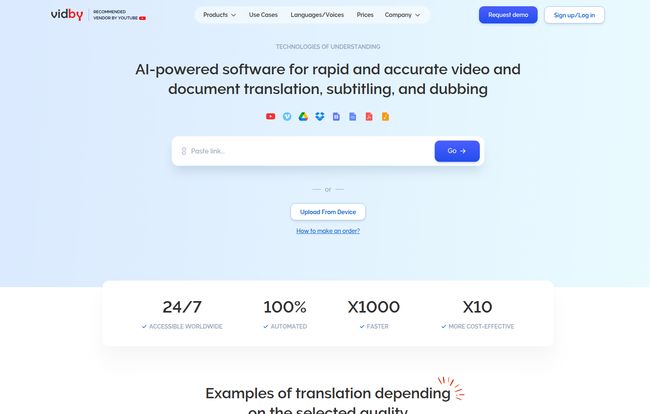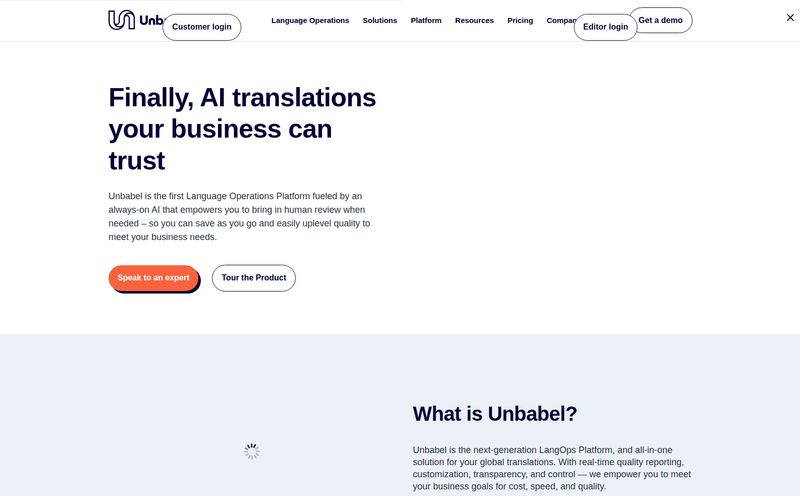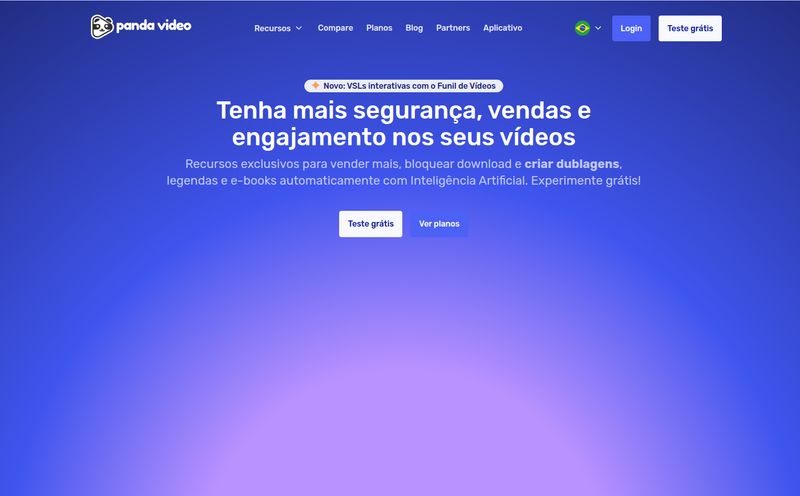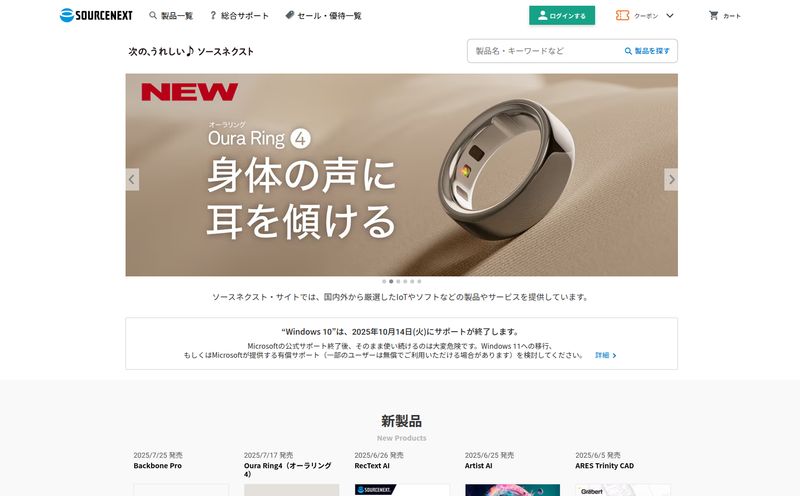I've been in the SEO and content game for a long time. Long enough to remember when taking content “global” was a monumental task. It meant finding a reliable translation agency, endless email chains, eye-watering quotes, and a turnaround time that could kill any campaign's momentum. It was a slow, expensive gatekeeping system that kept most creators and businesses locked into their home turf.
Then AI came along, promising to tear down those walls. We’ve all seen the early, often hilarious, results of machine translation. Those cringey YouTube captions or website footers that make absolutely no sense. But the tech has been quietly getting good. Scary good, in some cases.
That brings me to Vidby. It’s one of the platforms at the forefront of this AI translation revolution, specifically for video. The promises are huge: 1000x faster, 10x more cost-effective. But as a seasoned (and maybe slightly cynical) marketer, I have to ask: does it actually work? Or is it just another tool that's great on paper but clumsy in practice? Let's get into it.
What Exactly is Vidby? (More Than Just Subtitles)
At its core, Vidby is an AI-powered service designed to translate, dub, and subtitle your video content. And your documents, too. With support for over 70 languages, the goal is simple: to help you speak to the world without needing to hire a small army of translators and voice actors. You just paste a link to your video or upload a file, and the platform gets to work.
But calling it just a “translation tool” feels like a bit of an undersell. It's a full platform. Think of it less as a simple transcriber and more as a localization hub. They’ve even managed to get partners like Google, Microsoft, and Samsung on board, which definitely lends them some street cred.

Visit vidby
The real magic, and the thing that caught my attention, is how they handle the thorny issue of quality.
The Vidby "Quality Tiers": Finding Your Goldilocks Zone
This is where Vidby gets really smart. They understand that not all content is created equal. A quick TikTok clip doesn’t need the same red-carpet treatment as a flagship product advertisement. So, they offer a spectrum of quality and pricing. I like to think of it like dinner options.
The Quick & Dirty: Full AI & Manual Dubbing
This is your instant noodles. For about $0.90 per minute, you get a fully automated AI translation and dubbing. Is it going to be perfect? Nope. The platform is pretty up-front about that. But for internal training videos, quick social media reactions, or just getting a feel for a new market, it’s fantastic. It’s fast, it's cheap, and it gets the basic message across. You're the one doing the final quality check here, so it's best for low-stakes content where a little AI jankiness is forgiveable.
The Professional Polish: Human-in-the-Loop
This is your favorite takeout spot. At around $14.35 per minute, you still get the speed of AI, but with a crucial extra step: a human expert reviews and corrects the subtitles and translation. This, for me, is the sweet spot for most professional use cases. Think e-learning modules, official YouTube tutorials, or corporate presentations. You get the scalability of AI without risking a major brand-damaging mistranslation. It's a smart hybrid model that makes a lot of sense.
The Hollywood Treatment: Real Voice Actors
And this is the Michelin-star meal. Coming in at $24.43 per minute, this tier includes the human expert review plus dubbing by professional voice actors. This is for the content that absolutely cannot be wrong. High-budget advertisements, animated shows, independent films. When the emotion and nuance of the human voice are just as important as the words themselves, this is the tier you choose. It's the most expensive, but it’s still a fraction of what traditional dubbing studios would charge.
Beyond Translation: What Else is in the Toolbox?
Vidby isn't just a one-trick pony. The platform has a few other neat features baked in that add to its value.
- Voice Cloning: This one is both cool and slightly unsettling, in the way a lot of new AI is. The platform can create a synthetic version of your own voice to speak the translated language. The quality can vary, but it’s a fascinating way to maintain a sense of personal brand across different languages.
- Video & Subtitle Editors: You're not getting Adobe Premiere here, but there are basic tools to trim your video and, more importantly, customize your subtitles. You can change fonts, colors, and positioning to match your brand style. It's a small touch, but a very welcome one.
- Document Translation: Let's not forget this. The same powerful translation engine can be used for your documents, making it a handy tool for localizing everything from marketing PDFs to support articles.
Let's Talk Money: The Vidby Pricing and Credit System
Okay, so how do you actually pay for all this? Vidby uses a subscription model that feeds into a credit system. It can be a little confusing at first glance, so let’s break it down. Think of it like going to an arcade. Your subscription is the entry fee, and it comes with a roll of tokens (Vidby Credits).
| Plan | Monthly Cost | Vidby Credits Included | Good For |
|---|---|---|---|
| Free | $0 | 0 | Quick tests and seeing how it works |
| Basic | $9.95 | 100 | Individuals or very light users |
| Starter | $35 | 300 | Small businesses and regular creators |
| Pro | $75 | 700 | Professionals and agencies with higher volume |
You then spend those credits on the per-minute translation services we talked about earlier. The higher-tier subscriptions also unlock more advanced features, like the transcription and voice cloning editors. An annual subscription gets you a 20% discount, which is pretty standard stuff. It’s a flexible system, but you do need to keep an eye on your credit usage, especially if you're processing a lot of content on the pricier 'Professional' or 'Actor' tiers.
My Honest Take: The Good, The Bad, and The AI
So, what’s the final verdict? After digging through it, I have to say I'm genuinely impressed. But it's not perfect.
The Good: The speed is a true game-changer. The ability to get a professionally reviewed translation back in a day instead of weeks is massive. The tiered quality system is brilliant and shows a real understanding of the market's needs. And the sheer breadth of 70+ languages opens up markets that were previously out of reach for most.
The Not-So-Good: Let's be honest, AI translation will probably never be 100% perfect. Nuance, cultural idioms, and humor can still get lost, even with human review. That's a risk you take. I also think the credit system could be explained a bit more clearly on the homepage for first-time visitors. And of course, the higher quality tiers are an investment. While more affordable than traditional methods, the costs for a large project can still add up.
Who is Vidby Actually For?
In my opinion, Vidby is a fantastic fit for a few key groups:
- YouTubers and Content Creators who want to multiply their audience by dubbing their videos into languages like Spanish, Hindi, or Portuguese.
- E-learning Companies that need to localize entire courses quickly and affordably, where the 'Professional' tier offers the perfect balance of quality and cost.
- Marketing Teams at SaaS companies or D2C brands looking to run global ad campaigns without a global-sized budget.
- Corporations needing to create internal training materials for their international offices.
Who isn't it for? If you need a legally certified translation of a single, critical document, you should probably still go to a certified human translator. This is a tool for scale and communication, not legal certification.
The Bottom Line
Vidby is a seriously powerful tool that effectively solves a major pain point for content creators and businesses. It makes video localization accessible, fast, and scalable. It’s not a magic button that creates flawless art—you still need to be smart about choosing the right quality tier for your content. But it's a massive leap forward. The days of global content being a walled garden for only the biggest corporations are numbered, and platforms like Vidby are holding the sledgehammer.
Frequently Asked Questions about Vidby
Is Vidby free to use?
Yes, Vidby offers a Free plan that lets you explore the platform's basic features. It's great for running a quick test, but for any real work, you'll need to subscribe to a paid plan to get Vidby Credits.
Can a human actually review my AI translation?
Absolutely. That's the main benefit of their 'Professional' tier ($14.35/min). An expert reviews and refines the AI-generated subtitles and translation to ensure accuracy and natural flow.
What are Vidby credits?
Think of them as tokens for the translation arcade. Your monthly or annual subscription (like Basic, Starter, or Pro) gives you a certain number of credits. You then spend these credits on the per-minute services like translation and dubbing.
Will my unused credits roll over to the next month?
Yes, according to Vidby's FAQ, unused credits from your subscription can be carried over to the next billing period, so you don't lose them if you have a slow month.
What’s the difference between dubbing and voice cloning?
Traditional dubbing (like in the 'Actor' tier) uses a real human voice actor to perform the script in a new language. Voice cloning uses AI to create a synthetic version of your own voice that speaks the new language. Dubbing offers more emotional performance, while cloning maintains vocal consistency.
Is Vidby better than hiring a freelance translator?
It's different. For video content at scale, Vidby is almost certainly faster and more cost-effective. For a single, highly nuanced document or a creative project that requires deep cultural adaptation, a specialized freelance translator might still have the edge. It's about the right tool for the job.



